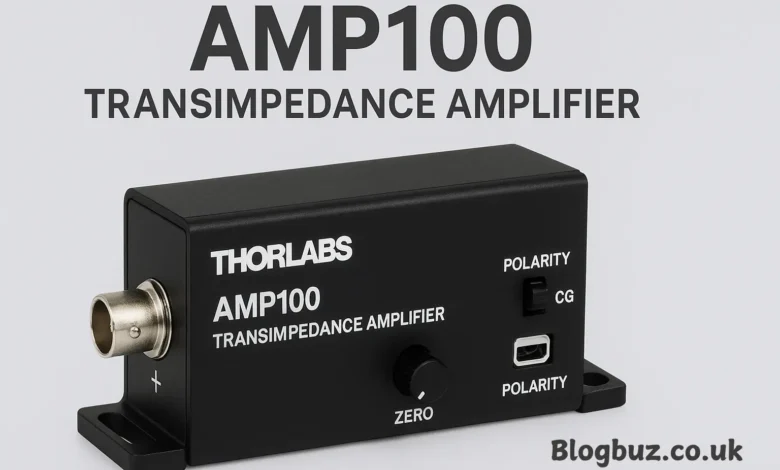AMP100 Transimpedance Amplifier: Features, Applications, and Performance Explained

In the world of precision optics, photonics, and low-light detection, a transimpedance amplifier (TIA) plays a crucial role in converting the minute current generated by a photodiode into a usable voltage signal. Among the reliable solutions available today, the AMP100 Transimpedance Amplifier from Thorlabs stands out as a compact, versatile, and user-friendly device designed for sensitive measurements. This article provides a comprehensive analysis of the AMP100 Transimpedance Amplifier, encompassing its design, technical specifications, applications, advantages and disadvantages, and comparisons with related models. By the end, you’ll understand why the AMP100 transimpedance amplifier is a go-to choice for laboratories, research setups, and precision measurement systems.
What is a Transimpedance Amplifier?
Before diving into the AMP100, it’s essential to understand the purpose of a transimpedance amplifier.
A TIA converts an input current (often from a photodiode or other current-output sensor) into a proportional voltage. The relationship is given by:
Vout = Iin × Rf
where Iin is the input current and Rf is the feedback resistance.
TIAs are widely used in:
- Optical detection systems
- Scientific instrumentation
- Laser power monitoring
- Low-light or fluorescence measurements
The AMP100 transimpedance amplifier is designed specifically for applications that demand sensitivity and stability at low frequencies.
Overview of the AMP100 Transimpedance Amplifier
The AMP100 transimpedance amplifier is a compact, inline device designed for easy integration with photodiodes. Released in December 2019 by Thorlabs, this product is ideal for researchers who require a stable, low-noise, and adjustable gain solution.
Key Highlights:
- Switchable gains of 1 MΩ, 10 MΩ, and 100 MΩ (1 MV/A, 10 MV/A, 100 MV/A).
- Bandwidth of DC to 1 kHz (–3 dB).
- Compact and lightweight at 80 g.
- USB-powered for convenience.
- Adjust the zero adjust knob to compensate for dark current offsets.
- Polarity switch for compatibility with both anode-grounded (AG) and cathode-grounded (CG) photodiodes.
The amplifier is specifically designed for use with low-light photodiode measurements, making it a popular choice in scientific and educational laboratories.
Technical Specifications of the AMP100 Transimpedance Amplifier
Here’s a breakdown of the official technical specifications:
| Specification | Value |
|---|---|
| Transimpedance Gain | 1 MV/A, 10 MV/A, 100 MV/A |
| Bandwidth (–3 dB) | DC – 1 kHz |
| Rise/Fall Time (10–90%) | < 300 µs |
| Maximum Input Current | ±2 µA (1 MV/A), ±200 nA (10 MV/A), ±20 nA (100 MV/A) |
| Maximum Output Voltage | ±1.0 V (50 Ω load), ±2.0 V (Hi-Z load) |
| Output Impedance | 50 Ω |
| Power Supply | 5 V via Micro-B USB (2 A supply included) |
| Dimensions | 97 × 32 × 25.4 mm (3.80 × 1.25 × 1.00 in) |
| Weight | ~80 g |
| Mounting Options | ECM100/ECM125/EPS125 mounting clamps |
| Release Date | December 6, 2019 |
| Price (as of 2025) | $575.56 USD |
These specifications make the AMP100 transimpedance amplifier a precision instrument tailored for sensitive low-frequency optical measurements.
Design and Build Quality
The AMP100 is built as a BNC female-to-female inline module, making it easy to insert between a photodiode and an oscilloscope, lock-in amplifier, or A/D converter.
Key design elements include:
- Compact enclosure that reduces space requirements.
- Side-mount clamps for secure positioning in laboratory setups.
- USB-powered system to eliminate the need for bulky external power supplies.
- Polarity and zero-adjust controls are accessible on the housing for quick calibration.
Overall, its design philosophy is convenience, simplicity, and precision.
Applications of the AMP100 Transimpedance Amplifier
The AMP100 transimpedance amplifier is widely used in optical and scientific fields where low currents must be measured with high sensitivity. Common applications include:
Fluorescence Detection
In life sciences, fluorescence signals are often extremely weak. The AMP100 can reliably amplify these signals, enabling accurate measurements.
Laser Power Monitoring
Photodiodes used for monitoring laser stability often generate tiny currents. The AMP100 helps convert these into readable voltages.
Low-Light Measurements
From astronomy to spectroscopy, low-light signals require highly sensitive amplifiers. The AMP100’s high transimpedance gain is ideal for such cases.
Optical Communication Research
While limited by its low bandwidth (1 kHz), the AMP100 can be used in educational experiments related to optical communications.
Signal Conditioning for ADCs
The AMP100 can act as a preamplifier for analog-to-digital converters, ensuring the signals fall within the ADC’s voltage range.
Advantages of the AMP100 Transimpedance Amplifier
The AMP100 transimpedance amplifier offers several benefits:
- Multiple gain settings (1, 10, and 100 MΩ) for flexibility.
- Compact and portable, ideal for laboratory benches.
- Easy USB power connection.
- Polarity switching for compatibility with different photodiode grounding schemes.
- Offset adjustment to cancel photodiode dark currents.
- Stable low-frequency performance suitable for long integration times.
Limitations of the AMP100 Transimpedance Amplifier
Despite its many advantages, the AMP100 transimpedance amplifier has limitations that users must consider:
- Low bandwidth (1 kHz) means it is not suitable for high-speed photodiode applications.
- Limited input current range, especially at high gain settings.
- Not designed for MHz or GHz optical communication signals—other amplifiers in the Thorlabs series are better suited for that domain.
- Relatively high cost ($575+) compared to simple op-amp-based DIY TIAs.
Comparison with Other Thorlabs Amplifiers
Thorlabs offers several transimpedance amplifiers, each suited to different frequency ranges and applications. Here’s how the AMP100 compares:
| Model | Gain Options | Bandwidth | Notes |
|---|---|---|---|
| AMP100 | 1/10/100 MΩ | DC – 1 kHz | Best for low-frequency, high-sensitivity |
| AMP102 | 1/10/100 kΩ | DC – 100 kHz | Higher speed, lower gain |
| AMP110 | Fixed 10 MΩ | DC – 1 kHz | Similar to AMP100, but single gain |
| AMP120 | Fixed 100 kΩ | DC – 100 kHz | Stable for mid-range signals |
| AMP130 | Fixed 1 kΩ | DC – 100 kHz | Suitable for higher input currents |
| AMP140 | Fixed 10 kΩ | DC – 10 MHz | High-speed photodiode work |
| AMP145 | Fixed 2.5 kΩ | DC – 100 MHz | Extremely high-speed optical detection |
From this comparison, it’s clear that the AMP100 transimpedance amplifier is best suited for sensitive, low-frequency optical experiments.
Buying and Availability
As of 2025, the AMP100 transimpedance amplifier is readily available from Thorlabs’ official website and authorized distributors.
- Price: USD 575.56
- Availability: Same-day shipping in many regions
- Included accessories: DS5 USB power supply and a 1.5 m USB cable
Optional mounting clamps and SMA adapter cables can be purchased separately.
Conclusion
The AMP100 Transimpedance Amplifier is a compact, flexible, and reliable solution for converting tiny photodiode currents into usable voltages. With its switchable gain options, polarity adjustment, and zero-offset calibration, it is ideal for researchers working with fluorescence detection, laser monitoring, and low-light measurements.
You May Also Read: Advancing Education at Unprg – Laboratorio E Meecnic E Fluidos – Ficsa




